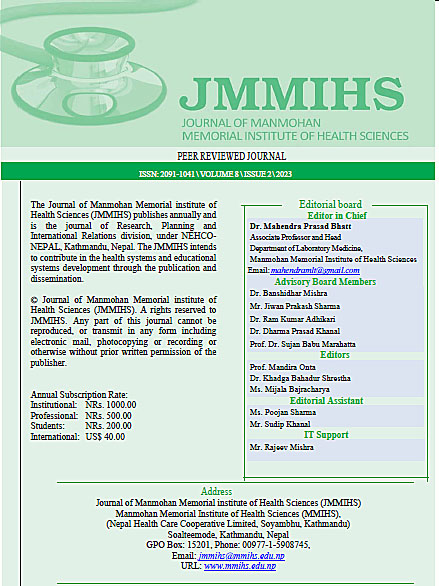Quality Evaluation Of Different Commercial Shampoo Brands Made In Nepal
DOI:
https://doi.org/10.3126/jmmihs.v8i2.59760Keywords:
Evaluation, Shampoo, Commercial, Medicated, Physiochemical, NepalAbstract
Background: Shampoo is one of the most popular cosmetic items for washing the hair and scalp. It is necessary to evaluate shampoo in order to understand its performance, quality, and effectiveness, as well as to ensure compliance with the standards of many journal articles.
Objective: The purpose of the research study was to evaluate the quality of four commercial and two medicinal shampoo brands made in Nepal.
Method: A cross-sectional, descriptive study was carried out in order to evaluate label information, microbiological quality, and physiochemical parameters such as (pH, density, viscosity, surface tension, foaming ability & stability, detergency power, wetting time etc. Furthermore, a UV-visible spectrophotometer was used to measure the percentage of assay of medicated sample.
Result: When compared to secondary data from journals, the study found that not all shampoos met specifications. It was found that only S5 of the six samples tested positive for microbial growth and exceeded the limit. Except for S5, the pH ranged between 5-7.The surface tension of all samples meets the specifications. S1-S4 had normal detergency power, however the medicated sample had low detergency power. All demonstrated good wetting time and dirt dispersion. The percentage of solid content in S1-S2 was very low. The assay percentage was within the prescribed range for medicated sample.
Conclusion: When compared to a standard journal, the study found that certain parameters were within range while some were out of range.
Downloads
Downloads
Published
How to Cite
Issue
Section
License
© Journal of Manmohan Memorial Institute of Health Sciences (JMMIHS)
All rights reserved to JMMIHS. Any part of this journal cannot be reproduced, or transmitted in any form including electronic mail, photocopying or recording or otherwise without prior written permission of the publisher.




